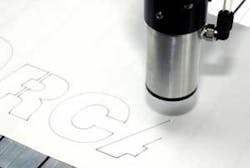Redmond, WA - The economic priorities of manufacturing are undergoing a fundamental shift. In the past, the priorities for manufacturing have been to achieve the lowest possible cost in non-stop production of a standardized product, while not compromising on consistency and quality. Manufacturers must now add a new priority to their list: flexibility. Modern consumers expect products that go far beyond meeting basic requirements by being adapted to their detailed preferences. The “standard” product isn’t enough in this era, no matter how low in cost.
To meet these requirements, highly adaptive flexible manufacturing will come into ever increasing use over the next few years. In the ideal scenario, a customer could specify product details at the time of order (more likely than not by clicking options on a web site), and receive a personalized product without any significant premium in time or price.
Laser materials processing, combined with the kind of highly adaptable software technologies that have emerged as a byproduct of the Internet revolution, can play a key role in this adaptive manufacturing process. Laser cutting, marking, engraving, and scoring deliver a manufacturing process that can be driven directly from computerized data sources. Open data transport approaches such as XML and SOAP allow this computer-driven process to be quickly and inexpensively integrated with existing business data flows.
Orca Photonics Systems Inc.’s laser cutting systems and application software are built around XML-based specification of design details and processing instructions for each laser cutting job. Because the XML file formats that drive this process are open and documented, it is straightforward to construct processing files in external software, and to deliver them into Orca’s laser processing flow without any detailed knowledge of the internal workings of the laser processing software. This standards-based approach means that laser processing can be integrated with other business information-processing infrastructure. The idea of an integrated system that constructs individual laser processing instructions directly from a customer order database, with no intervening manual processing, is well within reach. Orca is working to build the software components that will enable this kind of flexible, creative manufacturing process to deploy with minimum cost and disruption.
The photo shows one simple example of this kind of data flow. Design details for the Orca logo were stored in XML. From there, they were turned into a laser marked sample “product,” simply by specifying the appropriate file in the incoming job queue. Although the design details were generated by the company’s software, they easily could have been output by software developed by the customer, with little or no need for custom development.
“We believe that this kind of highly integrated, standards-based workflow will be very much the way of the future,” says Steve Moody, company vice president of development. The company recently has received an order for a unique laser cutting system designed for on-demand production of paper and corrugated packaging products. This machine, which is being developed in collaboration with a major packaging customer, will eventually provide capability for direct production individualized complete packages, driven in real time from incoming customer order data.
For more information, visit www.orcaphotonics.com.
